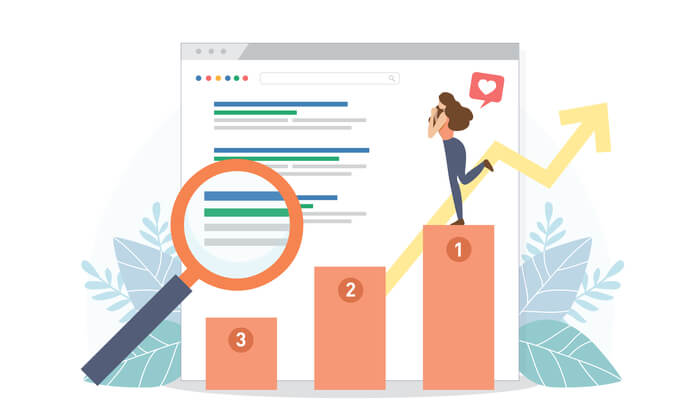Be in the know
With so many customization options in your Google My Business profile, it can be tough to decide what to focus on. But when it comes to ranking on the SERP, there are actually only four GMB fields that influence where your business will land.
In this article, we take you through the fields our team has found to impact rankings.
How Does Google Determine Local Ranking?
Google’s algorithm incorporates several ranking factors for search engine results. Whether you’re looking to rank higher by showcasing customer reviews, pop up in relevant searches to prospective customers, or ramp up your digital marketing game, understanding how Google determines local rankings is important.
Here are the three main factors that Google takes into account:
- Relevance: How relevant is your business to the keywords? Does it fit what the customer is looking for? If yes, your business name and other business information will appear in local search results.
- Distance: If customers in the vicinity are looking for a nearby business to fulfill their needs, you can link your GMB listing to Google Maps. This will allow new customers to find you. This strategy is especially beneficial for local home service businesses such as plumbers, electricians and HVAC contractors.
- Prominence: The more social media presence and online PR your business has, the higher Google will rank it. This doesn’t mean using a trick like duplicate listings. If you want your business to rank in a search query, making your brand and offering prominent will improve your search engine optimization.

What is Relevance?
Relevance is the degree to which a listing “matches” the search.
For example, if you are searching for a “car mechanic”, the algorithm will try to match your search keywords by returning businesses that primarily have those words in the business name or related categories.
Relevance is improved by adding complete and detailed business information to help Google better understand your business and match your listing to relevant searches.
How Distance Helps in GMB Ranking?
If you are a business in Maryland, chances are you will not be able to entertain any consumer from say, India. So specify your location and territory properly. If a user doesn’t specify a location in their search, Google will calculate distance based on the user’s location through GPS. Sneaky right!
What is Prominence?
Prominence refers to the strength of the business in terms of SEO.
We can demonstrate the influence of prominence by using the same image from above. Notice how the business listing which is ranked first has the same category as the business in second position, and is also further away. However, it is most likely in first position due to the fact that is has many more high ranking reviews. Because of its generally good, consistent reputation and plenty of search engine power, Starbucks has more prominence than Mike’s Coffee Shop and will dominate the local area, except when proximity takes over at Mike’s doorstep.
Add Relevant Information and Keywords to your listing
Make sure that your business information in Google My Business is accurate, and engaging. Add good quality images to your business profile, especially if you are a local business operating offline. If you want to rank higher in Google Maps through organic search, avoid unnecessary keyword stuffing. Remember, SEO doesn’t mean to give overdose of keywords but to optimize them. Google has made it’s algorithm very specific on that note.
You need to complete every section of your Google My Business dashboard. Keep your name, address, and phone number consistent. The phone number serves best if local; or else a mail ID serves the purpose well. Properly describe and categorize your business to help Google to find you.

Ensure Your Site is Mobile-Friendly (and Ready For a Mobile-First Google)
More than half of all website traffic comes from a mobile device. That means if you want to rank well, your site needs to perform well on mobile.
While some algorithm changes remain unclear, Google left nothing to the imagination when it comes to mobile.
Then in 2020, Google moved to “mobile-first indexing” which means Google looks at websites as a mobile device. If your site is hard to navigate, your ranking will be impacted.
Luckily, it’s pretty easy to see where you stand. Google’s mobile-friendly test offers a quick way to determine if your site is mobile-friendly or on its way to Penaltyville.

Relevance Factor Components
Google has provided many fields for Google My Business listing managers to fill out. Many of these fields contribute to the assessment of relevance. The most important ones are:
- Business Name
- Categories
- Services
- About
- Offerings
- Description
The information found in these fields directly or indirectly helps the algorithm match a listing to a search query.
Other information that can provide relevant information is text that comprises reviews and the Q&A section.
Distance Factor Components
The closer a searcher is to the address of your listing, the higher it will rank. There is not much you can do as a Google My Business profile owner to influence this factor.
However, the algorithm does contain some complexity that will moderate results. For example, all these searches may return different results for the same person as the algorithm tries to adjust to provide the best results:
- Dentist
- Dentist near me
- Dentist Springfield
Trying to optimize your Google My Business profile and website for different variants of these types of searches is good practice.
Also, note that zip codes have nothing to do with rankings. This is an artificial element because many rank trackers are based on zip code centers. Any scan with Local Falcon will demonstrate that crossing zip code boundaries does not affect ranking in any way.
Prominence Distance Components
This is the most complicated ranking factor as it is derived from a multitude of, most of which are kept secret by Google. However, we do know (from the above-quoted text) that Google assesses:
- Directories (how well the citation information matches the Google My Business information)
- Reviews (positive sentiment)
- General optimization of your Google My Business associated website
- Backlinks to your website
- Website content matching Google My Business categories
Other factors they did not mention, but we have surmised to influence ranking directly or indirectly are:
- Age of the Google My Business listing
- Driving direction requests
- Interactions with the Google My Business listing (how many times people click on the listing to read reviews and posts, view photos, etc.)
There is debate in the SEO community about a new ranking factor called E.A.T, which stand for Expertise, Authoritativeness, and Trustworthiness. At this point there is no concensus about the specifics factors that influence E.A.T., nor is there any proof that it affects Google Maps rankings.
Last bit of advice
To increase your business visibility and revenue, a business listing on Google Maps is one of the must tasks to perform. It allows the consumers to quickly get the information they need and make informed purchasing decisions.
Follow the tips with a clear understanding of what Google My Business is and how it validates your local ranking. Rank higher on Google Maps by optimizing your website and the listing. Both are important!
All being said, if you have a new website, ranking for a competitive keyword can take time. You have to be patient and understand that you are up against multiple websites who are performing all those off-page, on-page activities. The more you walk the web, the more backlinks you collect.
These backlinks work as gold mines for your website’s traffic and visibility. Once you have done all of these and added enough original content under every necessary box, keep adding guest posts until you hit the 3-pack.
